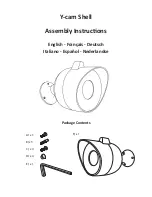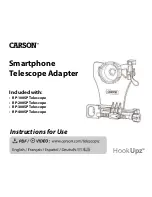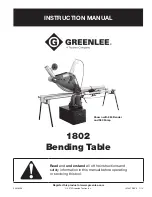
SIGMA TANDEM SYSTEM OWNER’S MANUAL
Page 4:X
Section 2: Equipment • Chapter 2 - Operation
11301 - 00.00.0000
After you have performed the above described emergency drills, have a partner act as a student
and suspend yourselves in a hanging Tandem harness. Repeat the emergency procedures enough
times to ensure that the movements become natural and instinctive. Take note of the different
positions of the handles while in a suspended mode. (Statistics have shown that the Tandem
Vector’s most common malfunction mode is a typical main canopy malfunction where the control
lines are entangled with the rear riser lines with a possible slider hang up. This problem can be
avoided by proper packing, maintaining good line tension throughout, and the use of proper stow
bands to prevent line dump.)
DO NOT TAKE THIS DRILL LIGHTLY. If you should ever experience a malfunction, this practice
will give you the skills needed to deal with the problem effectively.
By ordering an extra pair of Tandem main risers and toggles, one can easily setup a training
harness with an actual Tandem system. Remove the entire main canopy assembly (from risers to
drogue) and suspend the system using the extra pair of risers. To prevent excessive wear of the
Tandem system, order or produce your own training harness to be used exclusively for training
and recurrency work.
CANOPY BRAKES AND STEERING SYSTEM
Deployment brake release
1) Grasp main steering toggles and pull outwards away from the riser, unsnapping the toggles.
Use the student toggle position during brake release.
2) Pull toggles down to release the brakes. Do not pull on the small black flare toggles - leave
them attached to the risers.
Double brake system for the Tandem Vector canopy
The Relative Workshop Double Brake System is an innovation in the steering line set up on
Tandem systems that provides reduced toggle pressure and faster turns during normal flight while
at the same time producing extra stopping power in low wind conditions.
As shown in Illustration #2/1-5 on page #10, there are seven steering lines (EZ425, 384 &
Sigma 370, 395, 340 models) on each side of the canopy. Unlike most canopies, the lines are a
ttached at the full cell junctions, rather than at the half cell point. When so much of the canopy tail
is pulled down for landing, it makes for an exceptional flare, and therefore, a softer landing. For
normal flight and turns, the inside lines are not needed. In fact, they are a hindrance during turns,
increasing toggle pressure, and slowing turn rate. To deal with this situation, the double brake
system has been set up so that the inside “extra” lines are used only during the flare for landing.
During main canopy opening, reach up and grab the right and left gold, lower student toggles
only (do not touch the black flaring toggle). Peel the toggles in a rearward direction for easy toggle
and brake release. If toggles are pulled straight down, their release will be difficult or impossible
due to the amount of velcro and the additional snap holding them in place, and you may cause
damage to both components.
For normal flight, from opening altitude down to approximately 500 feet, use only the gold toggles.
Prior to landing, reach up and take the black flaring toggles by inserting four fingers and closing
your grip. Now you are ready to land. The black toggles lay flat and may be difficult to access
Summary of Contents for TANDEM VECTOR
Page 1: ......
Page 4: ......
Page 6: ...CHAPTER 1 THESIGMA TANDEMSYSTEM CHAPTER 1 THESIGMA TANDEMSYSTEM...
Page 11: ......
Page 12: ...CHAPTER 2 APPLICANT COURSE INFORMATION CHAPTER 2 APPLICANT COURSE INFORMATION...
Page 17: ......
Page 19: ...CHAPTER 1 DESCRIPTION CHAPTER 1 DESCRIPTION...
Page 31: ......
Page 32: ...CHAPTER 2 OPERATION CHAPTER 2 OPERATION...
Page 38: ......
Page 39: ...CHAPTER 3 RESERVE CONTAINER CHAPTER 3 RESERVE CONTAINER...
Page 71: ......
Page 72: ...CHAPTER 4 MAINCONTAINER CHAPTER 4 MAINCONTAINER...
Page 104: ......
Page 106: ...CHAPTER 1 PREPARATION CHAPTER 1 PREPARATION...
Page 114: ......
Page 115: ...CHAPTER 2 IN AIRCRAFT EXITS...
Page 118: ......
Page 119: ...CHAPTER 3 FREEFALL DROGUE FALL CHAPTER 3 FREEFALL DROGUE FALL...
Page 125: ......
Page 126: ...CHAPTER 4 CANOPY CONTROL CHAPTER 4 CANOPY CONTROL...
Page 130: ......
Page 132: ...CHAPTER 1 RESERVE PROCEDURES CHAPTER 1 RESERVE PROCEDURES...
Page 135: ......
Page 136: ...CHAPTER 2 AIRCRAFT EMERGENCIES STUDENT REFUSAL CHAPTER 2 AIRCRAFT EMERGENCIES STUDENT REFUSAL...
Page 139: ......
Page 140: ...CHAPTER 3 FREEFALL CHAPTER 3 FREEFALL...
Page 145: ......
Page 146: ...CHAPTER 4 CANOPY CONTROL CHAPTER 4 CANOPY CONTROL...
Page 149: ......
Page 151: ...CHAPTER 1 STUDENTSKILLS FORFIRSTJUMP CHAPTER 1 STUDENTSKILLS FORFIRSTJUMP...
Page 155: ......
Page 156: ...CHAPTER 2 OTHER ACTIVITIES CHAPTER 2 OTHER ACTIVITIES...
Page 159: ......
Page 160: ...APPENDIX...
Page 167: ...SIGMATANDEMSYSTEMOWNER SMANUAL Page8 X Section6 Appendix 11301 00 00 0000...
Page 168: ...Page9 X SIGMATANDEMSYSTEMOWNER SMANUAL 11301 00 00 0000 Section6 Appendix...
Page 169: ...SIGMATANDEMSYSTEMOWNER SMANUAL Page10 X Section6 Appendix 11301 00 00 0000...
Page 170: ...Page11 X SIGMATANDEMSYSTEMOWNER SMANUAL 11301 00 00 0000 Section6 Appendix...
Page 171: ...SIGMATANDEMSYSTEMOWNER SMANUAL Page12 X Section6 Appendix 11301 00 00 0000...
Page 172: ...Page13 X SIGMATANDEMSYSTEMOWNER SMANUAL 11301 00 00 0000 Section6 Appendix...
Page 173: ...SIGMATANDEMSYSTEMOWNER SMANUAL Page14 X Section6 Appendix 11301 00 00 0000...
Page 174: ...Page15 X SIGMATANDEMSYSTEMOWNER SMANUAL 11301 00 00 0000 Section6 Appendix...
Page 175: ......















































